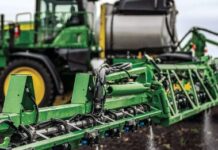|
Kansas’ 2020 Upland Game Bird Seasons Look Promising Posted: 21 Oct 2020 01:54 PM PDT PRATT – November 14 marks the opening day for Kansas’ regular quail and pheasant seasons, and November 21 marks the opening day of Kansas’ regular greater prairie chicken season. This year, the outlook looks promising, as both popular upland game bird populations appear to be faring well. But when opportunities exist statewide, it can sometimes be difficult for upland bird hunters to narrow down the best locations to hunt. That’s where the 2020 Kansas Upland Bird Forecast comes in handy. The forecast – produced annually by the Kansas Department of Wildlife, Parks and Tourism (KDWPT) – is compiled from data collected during spring calling surveys for pheasants (crow counts), quail (whistle counts), and prairie chickens (lek counts), as well as late-summer roadside surveys for pheasants and quail. The 2020 Kansas Upland Bird Forecast, available online at ksoutdoors.com/Hunting/Upland-Birds, includes the following highlights: Quail Data suggests Kansas might again have one of the nation’s best bobwhite quail harvests this season, with dense populations of quail in central Kansas. “Our quail did amazing things again, especially in north-central Kansas,” said Jeff Prendergast, KDWPT small game specialist. “Some landowners have told me they’ve never seen it like this and some have been farming 40 or 50 years. People need to get out and enjoy this while it’s this good.” Numbers look especially promising in much of south-central Kansas, too. Southwest Kansas could have some good pockets of birds, and while northeast Kansas saw a significant population increase, it will likely not compete with locations further west. Pheasants Northwest and north-central Kansas should have the state’s best pheasant numbers this season. There, populations are similar to last season when Kansas ranked second in the nation for quality pheasant hunting. Though, hunters should note: Great hunting spots may be more fragmented than usual because of summer rains. “Hunters could have an exceptional day in one spot, then move a couple of miles and hardly find any birds,” said Prendergast. “Where we had those rains, the birds should have done fairly well.” Pheasant populations in south-central Kansas may be slightly down from last season, but good pockets of birds are still to be expected. Like north-central Kansas, the region should produce good mixed bag hunting. “Hunters who’d like to focus on quail and take pheasants as they come, should be pretty happy this year,” said Prendergast. “Southwest Kansas will also have some good localized populations.” Prairie Chickens While greater prairie chickens have declined in eastern regions, the population appears to have expanded in numbers and range in the northwestern portion of the state. This fall, hunting opportunities for greater prairie chickens will be best in the Northern High Plains and Smoky Hills Regions, where populations have either increased or remain stable, and where public access is more abundant. Note, all prairie chicken hunters are required to purchase a $2.50 Prairie Chicken Permit, available at kshuntfishcamp.com. The Southwest Prairie Chicken Unit, where lesser prairie chickens are found, will again remain closed to hunting this year. Regardless of preferred upland bird species, hunters can be as mobile as needed when utilizing Kansas’ 1.7 million acres of scattered public hunting lands. Much of the state’s one million-plus acres are tracts enrolled in KDWPT’s Walk-In Hunting Access program – commonly referred to as WIHA – and sit as a patchwork throughout the state’s main pheasant range. Hunters may also find quality bird hunting opportunities through the department’s newest public access program, iWIHA. Through iWIHA, hunters can reserve hunting access on private lands with limited access. For more information on WIHA and iWIHA, or to view maps of lands open to public hunting, visit ksoutdoors.com. Pheasant and quail seasons run through Jan. 31 in Kansas, so there’s plenty of time to plan. In the meantime, grab a license at kshuntfishcamp.com or through KDWPT’s mobile app, HuntFish KS, and prepare to enjoy a fall season unlike any other. ### |
| KDWPT Among First in the Nation to Make Hunting Information Available in Spanish
Posted: 21 Oct 2020 01:42 PM PDT PRATT – The Kansas Department of Wildlife, Parks and Tourism – in partnership with the Kansas Wildlife Federation and the Kansas Hispanic and Latino American Affairs Commission – is taking its first large stride toward making hunting and other outdoor recreation-related information available to a wider audience. New this month, on KDWPT’s Espanol webpage, ksoutdoors.com/Espanol, is the department’s first-ever Spanish-language version of the 2020-2021 Kansas Hunting and Furharvesting Regulations Summary, 2020-2021 la caceria y recoleccion de pieles de Kansas resumen de regulaciones. The 48-page, full color document contains critical information related to Kansas’ hunting and trapping seasons, license and permit requirements, unit boundary maps, office and staff contact information, and more. It’s just once facet of KDWPT’s all-new language access program, “Afuera Para Todos” meaning “Outdoors For All.” As part of Afuera Para Todos, KDWPT has immediate plans to offer additional Spanish-translated materials, to include the 2021 Kansas Fishing Regulations Summary (produced annually), 2022-2023 Kansas Boating Regulations Summary (produced every two years), area signage, website and social media content, and more. “At KDWPT, our responsibility is to manage Kansas’ natural resources and to serve those who wish to engage in outdoor recreation associated with those natural resources, regardless of ethnicity or preferred language,” said KDWPT Secretary Brad Loveless. “While we recognize the tremendous opportunity that exists here for us to expand our user-base, more importantly, we know it’s simply the right thing to do. I’ve encouraged and challenged my staff to continue identifying and removing barriers for our state’s most underrepresented groups because the reality is, language is just one barrier of many that might affect a Kansans’ ability to engage with our agency and Kansas outdoors, but this effort is certainly a great place to start.” In addition to offering Spanish-translated materials, KDWPT has increased its capacity to field phone and email communications in Spanish through the hiring of a dedicated bilingual information representative. Information on how to utilize this resource can be found at ksoutdoors.com/Espanol. However, the improvements don’t stop there. Beginning in 2021, other mission critical priorities for KDWPT will include increased diversity in the agency’s marketing and promotional materials, as well as its workforce. “‘Diversity,’ ‘Equity’ and ‘Inclusion’ aren’t just going to be ‘power words’ that live and die on a planning document at our agency,” said Nadia Reimer, KDWPT chief of Public Affairs. “This is our agency’s commitment to creating a culture of inclusivity where underrepresented groups are authentically recognized and welcomed as valuable members of the Kansas natural resource community, and it’s also our commitment to creating a workforce that more closely represents the constituents we serve.” ### |




